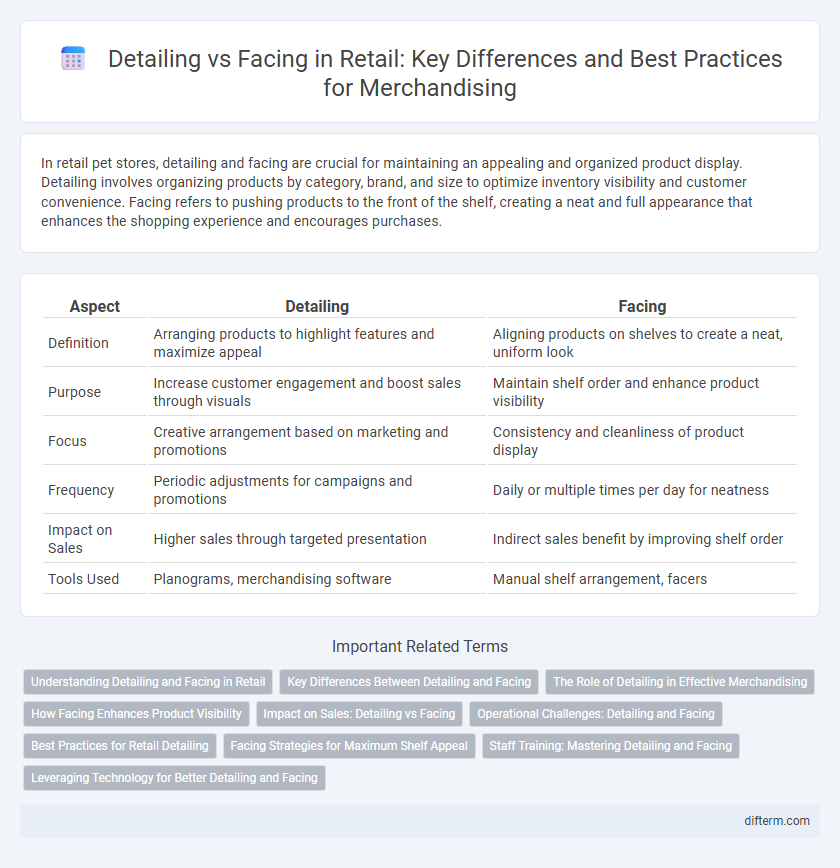In retail pet stores, detailing and facing are crucial for maintaining an appealing and organized product display. Detailing involves organizing products by category, brand, and size to optimize inventory visibility and customer convenience. Facing refers to pushing products to the front of the shelf, creating a neat and full appearance that enhances the shopping experience and encourages purchases.
Table of Comparison
| Aspect | Detailing | Facing |
|---|---|---|
| Definition | Arranging products to highlight features and maximize appeal | Aligning products on shelves to create a neat, uniform look |
| Purpose | Increase customer engagement and boost sales through visuals | Maintain shelf order and enhance product visibility |
| Focus | Creative arrangement based on marketing and promotions | Consistency and cleanliness of product display |
| Frequency | Periodic adjustments for campaigns and promotions | Daily or multiple times per day for neatness |
| Impact on Sales | Higher sales through targeted presentation | Indirect sales benefit by improving shelf order |
| Tools Used | Planograms, merchandising software | Manual shelf arrangement, facers |
Understanding Detailing and Facing in Retail
Detailing in retail refers to the strategic placement and presentation of products to maximize visibility and appeal, influencing customer buying behavior. Facing involves organizing products on shelves so that front labels face forward, enhancing product visibility and creating a clean, attractive display. Both detailing and facing work together to boost sales by improving product accessibility and store aesthetics.
Key Differences Between Detailing and Facing
Detailing in retail involves strategically placing products and information to maximize customer engagement and sales, emphasizing product benefits and targeted marketing. Facing refers to arranging products on shelves with uniform fronts to create an attractive, organized appearance, enhancing visibility and accessibility. Key differences include detailing's focus on promotional messaging and consumer influence, while facing prioritizes shelf orderliness and inventory presentation.
The Role of Detailing in Effective Merchandising
Detailing in retail merchandising enhances product visibility and customer engagement by strategically placing items to highlight key features and benefits. Unlike facing, which simply ensures products are neatly aligned and fronted on shelves, detailing involves customized adjustments such as signage, lighting, and arrangement tailored to drive interaction and sales. Effective detailing leverages consumer psychology and data-driven insights to optimize store layout, improving both brand perception and purchase likelihood.
How Facing Enhances Product Visibility
Facing in retail ensures that all products are aligned and fronted on the shelves, creating a clean, organized appearance that draws customer attention. Proper facing highlights product labels and branding, significantly increasing visibility and making it easier for shoppers to locate desired items. Enhanced product visibility through facing directly impacts sales by promoting impulse purchases and encouraging brand recognition.
Impact on Sales: Detailing vs Facing
Detailing enhances sales by delivering personalized product information that influences purchasing decisions, creating stronger customer engagement and brand loyalty. Facing optimizes product visibility and shelf organization, which increases impulse buys and reduces out-of-stock incidents by maintaining consistent product presence. Combining effective detailing with strategic facing drives higher sales through both informed customer choices and improved product accessibility.
Operational Challenges: Detailing and Facing
Operational challenges in retail detailing and facing include ensuring consistent product placement and maintaining shelf appearance to enhance customer experience and maximize sales. Retail staff often struggle with time constraints and frequent restocking demands, which complicate accurate facing of items and detailed arrangement. Efficient training and process optimization are critical to overcoming these obstacles and achieving visual merchandising standards.
Best Practices for Retail Detailing
Retail detailing involves meticulously organizing and cleaning shelves to enhance product visibility and appeal, while facing ensures all products are uniformly pulled forward creating a neat and consistent look. Best practices for retail detailing include maintaining clean and clutter-free shelves, aligning products uniformly at shelf edges, and regularly rotating stock to manage inventory effectively. Employing these strategies boosts customer experience and maximizes sales potential by presenting products in the most attractive and accessible manner.
Facing Strategies for Maximum Shelf Appeal
Facing strategies in retail are critical for maximizing shelf appeal by ensuring products are consistently visible and organized at eye level, which directly influences consumer purchasing decisions. Employing optimal facing techniques, such as front-facing items with clear labels and maintaining full facings to avoid gaps, enhances product visibility and encourages impulse buys. Regularly auditing shelf facings helps retailers optimize space utilization and adapt to changing consumer behavior for improved sales performance.
Staff Training: Mastering Detailing and Facing
Staff training in retail emphasizes mastering detailing and facing to enhance product visibility and boost sales. Detailing involves providing in-depth product knowledge to customers, while facing ensures shelves are organized and attractive by neatly arranging products at the front. Proper training equips employees to execute these tasks effectively, improving customer experience and store aesthetics.
Leveraging Technology for Better Detailing and Facing
Leveraging technology in retail detailing and facing enhances shelf management by utilizing planogram software and shelf scanning devices to ensure accurate product placement and inventory levels. Automated facing solutions enable real-time monitoring and replenishment, reducing out-of-stock scenarios and improving visual merchandising consistency. Integrating AI-driven analytics allows retailers to optimize product assortment and layout based on consumer behavior patterns, driving increased sales and customer satisfaction.
detailing vs facing Infographic

 difterm.com
difterm.com